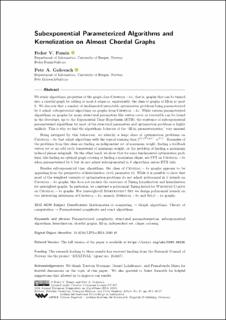| dc.contributor.author | Fomin, Fedor | |
| dc.contributor.author | Golovach, Petr | |
| dc.date.accessioned | 2021-05-19T12:25:10Z | |
| dc.date.available | 2021-05-19T12:25:10Z | |
| dc.date.created | 2021-01-04T12:06:02Z | |
| dc.date.issued | 2020 | |
| dc.Published | Leibniz International Proceedings in Informatics. 2020, 173 49:1-49:17. | |
| dc.identifier.issn | 1868-8969 | |
| dc.identifier.uri | https://hdl.handle.net/11250/2755698 | |
| dc.description.abstract | We study algorithmic properties of the graph class Chordal-ke, that is, graphs that can be turned into a chordal graph by adding at most k edges or, equivalently, the class of graphs of fill-in at most k. We discover that a number of fundamental intractable optimization problems being parameterized by k admit subexponential algorithms on graphs from Chordal-ke. While various parameterized algorithms on graphs for many structural parameters like vertex cover or treewidth can be found in the literature, up to the Exponential Time Hypothesis (ETH), the existence of subexponential parameterized algorithms for most of the structural parameters and optimization problems is highly unlikely. This is why we find the algorithmic behavior of the "fill-in parameterization" very unusual. Being intrigued by this behaviour, we identify a large class of optimization problems on Chordal-ke that admit algorithms with the typical running time 2^𝒪(√k log k) ⋅ n^𝒪(1). Examples of the problems from this class are finding an independent set of maximum weight, finding a feedback vertex set or an odd cycle transversal of minimum weight, or the problem of finding a maximum induced planar subgraph. On the other hand, we show that for some fundamental optimization problems, like finding an optimal graph coloring or finding a maximum clique, are FPT on Chordal-ke when parameterized by k but do not admit subexponential in k algorithms unless ETH fails. Besides subexponential time algorithms, the class of Chordal-ke graphs appears to be appealing from the perspective of kernelization (with parameter k). While it is possible to show that most of the weighted variants of optimization problems do not admit polynomial in k kernels on Chordal-ke graphs, this does not exclude the existence of Turing kernelization and kernelization for unweighted graphs. In particular, we construct a polynomial Turing kernel for Weighted Clique on Chordal-ke graphs. For (unweighted) Independent Set we design polynomial kernels on two interesting subclasses of Chordal-ke, namely, Interval-ke and Split-ke graphs. | en_US |
| dc.language.iso | eng | en_US |
| dc.publisher | Dagstuhl Publishing | en_US |
| dc.rights | Navngivelse 4.0 Internasjonal | * |
| dc.rights | Navngivelse 4.0 Internasjonal | * |
| dc.rights.uri | http://creativecommons.org/licenses/by/4.0/deed.no | * |
| dc.title | Subexponential Parameterized Algorithms and Kernelization on Almost Chordal Graphs | en_US |
| dc.type | Journal article | en_US |
| dc.type | Peer reviewed | en_US |
| dc.description.version | publishedVersion | en_US |
| dc.rights.holder | Copyright 2020 The Authors | en_US |
| cristin.ispublished | true | |
| cristin.fulltext | original | |
| cristin.qualitycode | 1 | |
| dc.identifier.doi | 10.4230/LIPIcs.ESA.2020.49 | |
| dc.identifier.cristin | 1864724 | |
| dc.source.journal | Leibniz International Proceedings in Informatics | en_US |
| dc.source.40 | 173 | |
| dc.source.pagenumber | 49:1-49:17 | en_US |
| dc.relation.project | Norges forskningsråd: 263317 | en_US |
| dc.identifier.citation | Leibniz International Proceedings in Informatics. 2020, 173, 49:1-49:17 | en_US |
| dc.source.volume | 173 | en_US |

